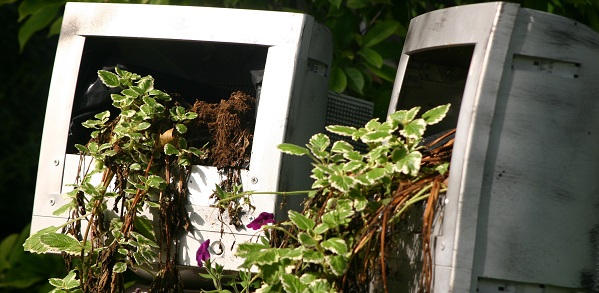
By Rachelle Gordon June 18, 2015
Electronic waste or “e-waste” is defined as unwanted or broken electric items that need to be discarded. E-waste is a broad term and can include everything from old tube television sets to broken smartphones. Unlike other trash, e-waste shouldn’t simply be tossed in a bin and sent to the landfill – the environmental risks are quite high due to the internal components. Instead, e-waste should be properly processed at a legitimate e-waste recycling center. If there is not one in your area, many cities offer free “e-waste clean up days” during which unwanted items can be brought to a certain place in town to be picked up by a processing center.What if I do throw out e-waste?
Unfortunately, e-waste can be a dangerous business that puts the environment and its inhabitants at risk. Many devices, especially computers, batteries and tube TVs, contain harmful materials such as heavy metals. When these unwanted electronics end up in landfills, they begin to leak out these toxic chemicals, endangering landfill workers, the landfill itself and often the surrounding community. Imagine a corroded battery exposing the heavy metals within that never fully break down to the environment – talk about danger zones.Are any electronics biodegradable?
The long answer is that technically, yes, everything decomposes eventually. But the amount of time this takes could literally be millions of years when it comes to electronics. Therefore, many materials are not considered biodegradable, as their decomposition time is too great to have any helpful impact. The main materials in e-waste are metal, plastic, glass and precious elements and metals. It is believed that glass really does not degrade – unless you’re willing to wait about a million years. Plastic is thought to take 500 years to break down, while metal differs greatly depending on type.How can I dispose of e-waste safely and legitimately?
As mentioned above, finding a legitimate e-waste recycling center is the best way to rid yourself of your junk electronics. Ensure that any centers you do find are certified and have a transparent paper trail. A recent UN report found that nearly 90 percent of the world’s e-waste is illegally traded or dumped, and you do not want any part in that. Many cities are responding to the growing amount of e-waste ending up in the dump or the wrong hands by developing their own processing systems or locations. In fact, New York State recently passed a law forbidding throwing away electronics – instead, e-waste must be brought to a designated drop zone.Don’t forget about buyback programs or free sites
Still desperate to rid yourself of that e-waste without harming the environment? Don’t wrack yourself with guilt when considering tossing those old USB cables in the garbage bin – why not try to sell or give away what you have? Many websites buy old electronics, as they may be repairable or used for parts. In addition, lots of retail stores, such as Best Buy, have drop boxes where you can dump old printers, computer monitors and VCRs for free – and with the knowledge that they will be sustainably processed. Don’t want to hassle with a trip to the store or signing up on a buyback sign? Many retailers, like Staples, also offer mail-in programs in which they give you a box to send in your electronics to be responsibly recycled.Whatever you have to do, try to avoid e-waste ending up in landfills at all cost. Electronics will pretty much never decompose, and the parts that do could potentially release dangerous and toxic heavy metals into the environment. Do your part (and your homework!) and get rid of that e-waste in an eco-friendly way.